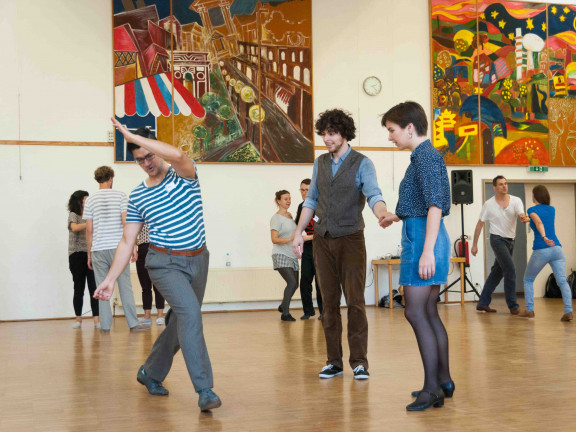How do I get people social to dance more quickly without getting too deep into technique?
Full Question:
How do I get people social to dance more quickly without getting too deep into technique? Meaning: I want to get people moving to music faster; how to get there without going too deep into the technique?
Video Answer:
Answer
There are many aspects to this challenge. Here we want to share a core principle that helps finding various solutions to this question.
For most people, if no other prompts are given, if you play a song created for dancing, people instinctively groove to it. They’ll have a decent overlap with their movements and the basic rhythm of the music. This works because they’re not overthinking what they’re doing, and simply allow their body to go with the flow of the music. We can call this “being in the body.” However, when we ask our students to move to the music with more specific patterns and ways of moving, we increasingly ask them to place some thinking capacity on top of their basic grooving. In other words, we ask them to add mental load to the process.
We like to think of it as a threshold that you can tip past, at which point the mental process can get so dominant as to cancel out whatever the body was intuitively doing. We can call this moment “being in the head”.
The challenge here is that once you cross this threshold, your students, and you as a teacher, will be very tempted to pile on more and more information, hoping to process it mentally and use it to execute the movement correctly. However, the more we move away from being in the body and into being in the head, even the simplest movements the students were doing correctly before can stop working.
You’ll see this expressed in questions like:
- Can you show the move to us many more times, in slow motion?
- Can you tell us exactly where your weight is on a particular count?
- Can we do only the first part of the move ten times slowly?
- Exactly how do you move at this moment?
Basically, they’re asking for anything that could provide more input to the mental process to control and command every aspect of their movements. As we move away from being in the body, we might say our bodies become more “stupid” for that moment. And then, we need to overload our minds to execute even the simplest movements.
With this way of looking at things, we can answer the original question like this: at every moment in class, you want to provide just enough information for the students to explore the new ideas and concepts without exceeding the threshold that switches them from being in their bodies to being in their minds. This approach typically creates a class in which your students explore the dance to music quite independently, which is exactly what they need to feel comfortable with social dancing.
Schedule a free 30-minute chat with Ali to geek out about teaching dance
Book a session with me to chat about dance teaching and explore any topics you want to discuss.
Note: This will not turn into a sales pitch! That, you can find here. Also, you won’t be added to any newsletter, you can sign up for that here.
We can discuss how to implement what you’re learning from this blog article, the challenges you face as a dance teacher or dance school owner, or any other topic about dance.
Of course, I hope that by getting to know me and my thinking better, you’ll trust that the full program will be of great value to you and that you’ll consider booking it. But I’ll leave that up to you.
I look forward to getting to know you. Book a session, and let’s meet!

Full Teacher Training Program
Kris and Ali have created an extensive Teacher Training Program for Dancers where you can delve deeper into how you can improve your dance teaching. You can learn all about it here: